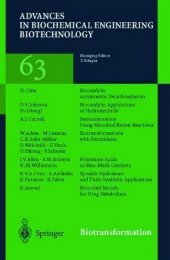Tidal Current Energy
Tidal Current Energy
Tidal Current Energy
Create successful ePaper yourself
Turn your PDF publications into a flip-book with our unique Google optimized e-Paper software.
330 D. Tondeur and F. Teng<br />
As regards research, while it is hard to see that a single breakthrough could<br />
solve all these problems, the challenges are numerous. For example, new<br />
approaches for getting rid of minor pollutants such as S, Cl, Hg, new materials<br />
for burners, boilers, turbines allowing higher temperatures, new membranes and<br />
solid oxygen carriers could change the technological and economic landscape.<br />
Some particular situations have favorable prospects and will certainly be leading<br />
examples in the large-scale deployment of CCS. Oil and gas production have<br />
been mentioned, with associated enhanced recovery and/or geological storage<br />
in aquifers. One also thinks of industrial processes that have a concentrated<br />
CO 2 stream, such as hydrogen production by reforming hydrocarbons. But the<br />
contribution of CCS to climate change mitigation will remain limited until existing<br />
power plants are massively updated with reliable technology. And it may<br />
be anticipated that this is likely to occur only when the cost of carbon rejected<br />
(the carbon tax) becomes ‘ comparable ’ to the cost of the carbon avoided.<br />
References<br />
1. IPCC ( 2005 ). Special Report on Carbon Dioxide Capture and Storage, Working Group III<br />
of IPCC ( B. Metz , O. Davidson , H. C. de Coninck , M. Loos and L. A. Meyer, eds).<br />
Cambridge University Press , Cambridge .<br />
2. Astarita , G. , D. W. Savage and A. Bisio ( 1983 ). Gas Treating with Chemical Solvents,<br />
Ch. 9: Removal of Carbon Dioxide . Wiley , New York .<br />
3. Chakma , A. ( 1997 ). CO 2 Capture Processes: Opportunities for Improved <strong>Energy</strong><br />
Efficiencies . <strong>Energy</strong> Conv. Mgmt. , 38 , S51 – S58 .<br />
4. Gwinner , B. , D. Roizard , F. Lapicque , et al. ( 2006 ). CO 2 Capture in Flue Gas: Semiempirical<br />
Approach to Select a Potential Physical Solvent . Ind. Eng. Chem. Res. , 45 ,<br />
5044 – 5049 .<br />
5. Ruthven , D. , S. Farooq and K. S. Knaebel ( 1994 ). Pressure-Swing Adsorption , p. 352.<br />
VCH , New York .<br />
6. Kikinides , E. S. , R. T. Yang and S. H. Cho ( 1993 ). Concentration and Recovery of<br />
CO 2 from Flue Gases by Pressure-Swing-Adsorption . Ind. Eng. Chem. Res. , 32 , 2714 .<br />
7. Ishibashi , M. , K. Otake , S. Kanamori and A. Yasutake ( 1999 ). Study on CO 2 Removal<br />
Technology from Flue Gas of Thermal Power Plant by Physical Adsorption Method .<br />
In Greenhouse Gas Control Technology ( P. Riemer , B. Eliasson and A. Wokaun , eds) ,<br />
pp. 95 – 100 . Elsevier , Oxford .<br />
8. Favre , E. ( 2007 ). Carbon Dioxide Recovery from Post-combustion Processes; Can<br />
Gas Permeation Membranes Compete with Absorption? J. Membrane Sci., in press.<br />
9. Castle , W. F. ( 1991 ). Modern Liquid Pump Oxygen Plants: Equipment and<br />
Performance, Cryogenic Processes and Machinery . AIChE Ser. No. 294 , 89 , 14 – 1 7 .<br />
10. Brandvoll, O. and O. Bolland ( 2004 ). Inherent CO 2 Capture using Chemical Looping<br />
Combustion in a Natural Gas Fired Power Cycle . ASME J. Eng. Gas Turbines Power ,<br />
126 , 316–321.<br />
11. Ishida , M. and H. Jin ( 2004 ). A New Advanced Power Generation System using<br />
Chemical Looping Combustion . <strong>Energy</strong> , 19 ( 4 ) , 415 – 422 .<br />
12. Richter , H. J. and K. Knoche ( 1983 ). Reversibility of Combustion Processes,<br />
Efficiency and Costing – Second-law Analysis . ACS Symp. Ser. , 235 , 71 – 8 5 .




